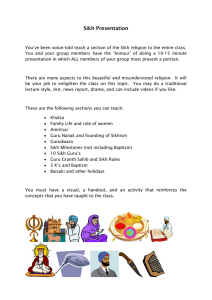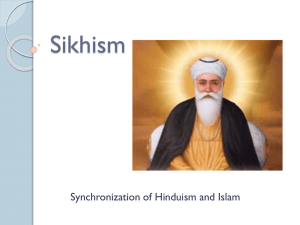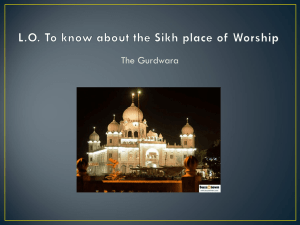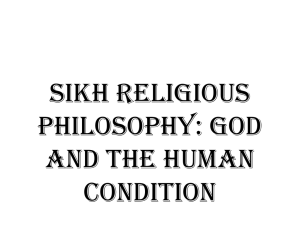Unit B582 - Sikhism 2 - Worship, community and family, sacred writings - Sample scheme of work and lesson plan booklet (DOC, 437KB)
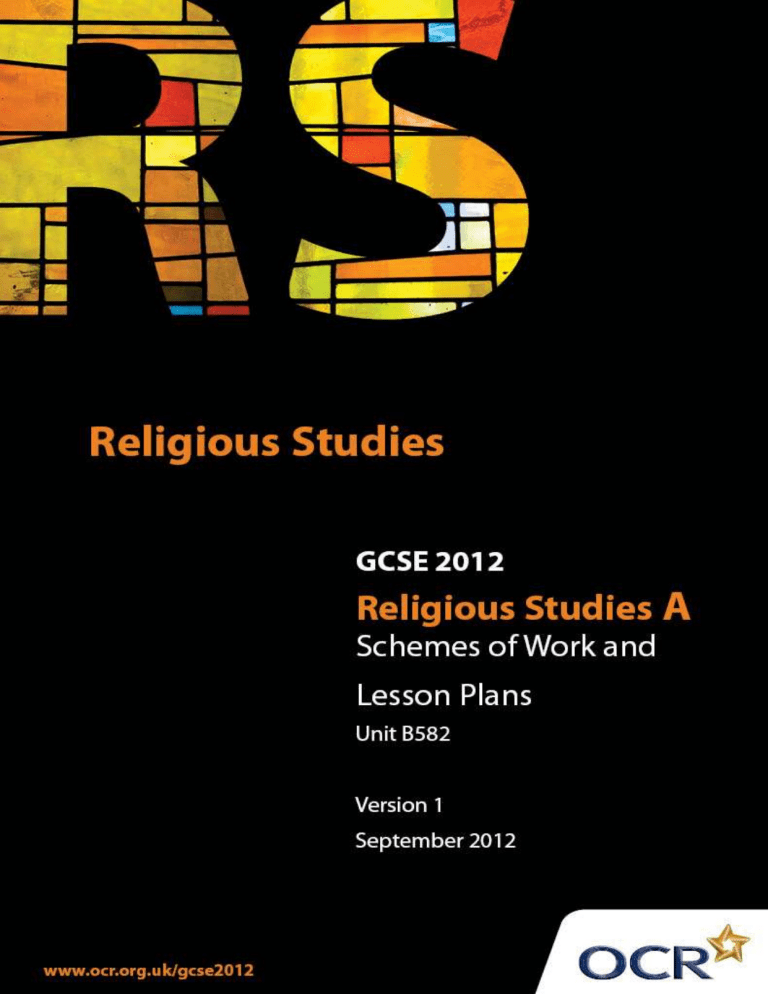
© OCR 2008
Contents
Introduction 3
Sample Scheme of Work: Unit B582: Sikhism 2 (Worship, Community and Family,
Sacred Writings) 6
Sample Lesson Plan: Unit B582: Sikhism 2 (Worship, Community and Family,
Sacred Writings)
Ошибка! Закладка не определена.
2 of 14 GCSE Religious Studies A (World Religion(s))
Introduction
Background
Following a review of 14 – 19 education and the Secondary Curriculum Review, the Qualifications and Curriculum Authority (QCA) has revised the subject criteria for GCSEs, for first teaching in
September 2009. This applies to all awarding bodies.
The new GCSEs have more up-to-date content and encourage the development of personal, learning and thinking skills in your students.
We’ve taken this opportunity to redevelop all our GCSEs, to ensure they meet your requirements.
These changes will give you greater control of assessment activities and make the assessment process more manageable for you and your students. Controlled assessment will be introduced for most subjects.
From September 2012 assessment tasks may be undertaken at any point between release of the task and the examination series for which the task must be submitted.
Centres must ensure that candidates undertake a task that is valid for submission in the year in which the candidate intends to submit it .
OCR has produced a summary brochure, which summarises the changes to Religious Studies A.
This can be found at www.ocr.org.uk
, along with the new specification.
In order to help you plan effectively for the implementation of the new specification we have produced these Schemes of Work and Sample Lesson Plans for Religious Studies A. These
Support Materials are designed for guidance only and play a secondary role to the Specification.
Our Ethos
OCR involves teachers in the development of new support materials to capture current teaching practices tailored to our new specifications. These support materials are designed to inspire teachers and facilitate different ideas and teaching practices.
Each Scheme of Work and set of sample Lesson Plans is provided in Word format – so that you can use it as a foundation to build upon and amend the content to suit your teaching style and students’ needs.
The Scheme of Work and sample Lesson plans provide examples of how to teach this unit and the teaching hours are suggestions only. Some or all of it may be applicable to your teaching.
The Specification is the document on which assessment is based and specifies what content and skills need to be covered in delivering the course. At all times, therefore, this Support Material
GCSE Religious Studies A (World Religion(s)) 3 of 14
booklet should be read in conjunction with the Specification. If clarification on a particular point is sought then that clarification should be found in the Specification itself.
4 of 14 GCSE Religious Studies A (World Religion(s))
A Guided Tour through the Scheme of Work
= Innovative Teaching Idea
This icon is used to highlight exceptionally innovative ideas.
= ICT Opportunity
This icon is used to illustrate when an activity could be taught using ICT facilities.
GCSE Religious Studies A (World Religion(s)) 5 of 14
Sample GCSE Scheme of Work
Unit B582: Sikhism 2 (Worship, Community and Family, Sacred
Writings)
SUGGESTED
TEACHING
TIME
12 HOURS TOPIC PLACES AND FORMS OF WORSHIP
TOPIC OUTLINE
Introduction
What is a gurdwara?
Describe the exterior and interior of a gurdwara.
The artefacts and symbols used as part of Sikh worship and how they help to symbolise the Sikh faith.
SUGGESTED TEACHING AND
HOMEWORK ACTIVITIES
Stimulus: various photos of different gurdwara have to show the typical architectural styles that may exist, the
Golden Temple being the most typical.
The definition of the gurdwara as the
‘gateway to the guru’ in that it contains the
Guru Granth Sahib.
The exterior of the gurdwara and how they may differ, the relevance of the Nishan
Sahib and the significance of the Khanda symbol.
The different rooms that make up the inside of the gurdwara and a brief overview as to what they might contain and why.
Review of previous lesson related to the inside of the gurdwara.
Beginning with the cloakroom and the rules which apply upon entry into the diwan hall, students explore the significance of each
SUGGESTED RESOURCES
Photos and internet research on the gurdwara available from a variety of websites.
This is RE 2 [ Large, Ingham and Parker]
The Sikh Experience [Emmet]
Sikhism For Today [Kanwaljit Kaur-Singh]
Discovering Sikhism [Penney]
Photos and internet research on the gurdwara available from a variety of websites.
This is RE 2 [ Large, Ingham and Parker]
POINTS TO NOTE
Students may use a variety of sources including internet research to compare the different styles of gurdwara.
Students should link the significance of the
Guru Granth Sahib as the word of the guru’s and its status as the final guru.
The relevance of symbolism to Sikh history, particularly the Khanda symbol related to
Guru Govind Rai Dev Ji and the Ik Ongkar symbol related to Guru Nanak dev Ji.
Emphasis should also be placed on how it is relevant to the modern day community of
Sikhs.
Students may approach the evaluation of the inside of the gurdwara by addressing the significance of each room under the following headings.
Room description
6 of 14
= Innovative teaching idea = ICT opportunity
GCSE Religious Studies A (World Religion(s))
Sample GCSE Scheme of Work
Unit B582: Sikhism 2 (Worship, Community and Family, Sacred
Writings)
SUGGESTED
TEACHING
TIME
12 HOURS TOPIC PLACES AND FORMS OF WORSHIP
TOPIC OUTLINE
How the symbols and artefacts might support and influence the beliefs and attitudes of worshippers.
SUGGESTED TEACHING AND
HOMEWORK ACTIVITIES room individually including the langar and the room set aside as a resting place for the
Guru Granth sahib.
Students are encouraged to reflect on the significance of the items of furniture and symbolism used, particularly in the diwan hall and how they reflect the status of the
Guru Granth Sahib.
SUGGESTED RESOURCES
The Sikh Experience [Emmet]
Sikhism For Today [Kanwaljit Kaur-Singh]
Discovering Sikhism [Penney]
POINTS TO NOTE
Content
Individual items of furniture or artefacts
Symbolism
Connection to the gurus.
= Innovative teaching idea
GCSE Religious Studies A (World Religion(s))
= ICT opportunity
7 of 14
Sample GCSE Scheme of Work
Unit B582: Sikhism 2 (Worship, Community and Family, Sacred
Writings)
SUGGESTED
TEACHING
TIME
9 HOURS TOPIC RELIGION IN THE COMMUNITY AND THE FAMILY
TOPIC OUTLINE
Introduction
What is a rite of passage?
How they help to keep the
Sikh community together
Initiation ceremonies
How they ensure the teachings of the tenth guru
SUGGESTED TEACHING AND
HOMEWORK ACTIVITIES
Students identify the main rites of passage from at least two world faiths to compare the similarities and differences between the ritual and belief connected to each
Students evaluate the significances of the ways in which the gurdwara is the focus for each rite of passage as well as other community activities, e.g. festivals, pilgrimage, spiritual development and how this might help to keep the Sikh community together
Amritsanskar- Initiation
Students focus on the content of the actual ceremony as a rite of passage
The relationship to taking amrit and
SUGGESTED RESOURCES POINTS TO NOTE
Internet research on rites of passage
Students
’ own personal experience reflected in speaking and listening activities.
Students may understand the significance of a messag rite of passage in two ways:
Because it is part of their life
Student’s personal and family memorabilia.
Because it holds more religious significance to some, than others
The Sikh Experience [Emmet]
The relevance of the rites of passage
Sikhism For Today [Kanwaljit Kaur Singh] ceremonies and how this helps to maintain
Discovering Sikhism [Penney]
Sikh culture and faith in countries where
Sikhs may be part of the minority world faiths is significant
Focus on gurdwara as the centre of their community and how its symbolism helps to maintain the main elements of Sikh faith
Internet research
The Sikh Experience [Emmet]
Sikhism For Today [Kanwaljit Kaur-Singh]
Consider the promises made by initiates at the amrit ceremony
Link the rules expected of those initiated to the willingness to make sacrifices as the g uru’s made also made sacrifices
8 of 14
= Innovative teaching idea = ICT opportunity
GCSE Religious Studies A (World Religion(s))
Sample GCSE Scheme of Work
Unit B582: Sikhism 2 (Worship, Community and Family, Sacred
Writings)
SUGGESTED
TEACHING
TIME
TOPIC OUTLINE
9 HOURS TOPIC RELIGION IN THE COMMUNITY AND THE FAMILY
Sewa
How the teachings of the guru’s are reflected b integral to the Sikh community.
SUGGESTED TEACHING AND
HOMEWORK ACTIVITIES childhood baptism should be defined and distinguished as two rites of passage, the first choice, and the second procedure
Students may wish to compare and contrast this to infant baptism and believer’s baptism or other significant rites of passage from their own faith
Becoming a Khalsa Sikh and remembering the significance of the festival of Baisakhi is integral to the amrit initiation ceremony.
Students should reflect on the key words, commitment, belonging, community
What is sewa, how did it become part of
Sikh faith and culture? Students reflect on the early childhood stories of Guru Nanak
Dev Ji and how the langar became the most significant part of performing sewa in the
Sikh community but that other forms also exist
SUGGESTED RESOURCES
The Sikh experience [Philip Emmet]
Sikhism For Today [Kanwaljit Kaur-Singh]
Discovering Sikhism [Penney]
www.khalsaaid.org.kabul.html
POINTS TO NOTE
Reflect on how the amrit ceremony maintains the teachings of Guru Govind
Singh Dev Ji
Suggest ways in which the amrit ceremony and the title kesh-dhari helps to keep the
Sikh community together
Students should be aware of the three main acts of Sewa and examples of the ways in which they may be performed
Students should be encouraged to link the act of Sewa to the teachings of the gurus and the rules to live by ‘Vand Chhakna- sharing with others who are less fortunate
= Innovative teaching idea
GCSE Religious Studies A (World Religion(s))
= ICT opportunity
9 of 14
Sample GCSE Scheme of Work
Unit B582: Sikhism 2 (Worship, Community and Family, Sacred
Writings)
SUGGESTED
TEACHING
TIME
TOPIC OUTLINE
9 HOURS TOPIC RELIGION IN THE COMMUNITY AND THE FAMILY
SUGGESTED TEACHING AND
HOMEWORK ACTIVITIES
Explore the significance of sewa in relation to the Sikh community and the different interpretations of sewa, intellectual, manual and material
How the caste system was challenged by the concept of Sewa
SUGGESTED RESOURCES POINTS TO NOTE than yourself
10 of 14
= Innovative teaching idea = ICT opportunity
GCSE Religious Studies A (World Religion(s))
Sample GCSE Lesson Plan
Unit B582: Sikhism 2 (Worship, Community and Family, Sacred Writings)
Places and Forms of Worship: The Gurdwara
OCR recognises that the teaching of this qualification above will vary greatly from school to school and from teacher to teacher. With that in mind this lesson plan is offered as a possible approach but will be subject to modifications by the individual teacher.
Lesson length is assumed to be one hour .
Learning Objectives for the Lesson
Objective 1
Objective 2
Objective 3
Students understand the meaning of the word gurdwara and why it is important to the Sikh faith.
Students research the different rooms of the gurdwara to evaluate how each area is designed to ensure that the teachings of the Sikh guru’s are maintained.
Students produce a guide booklet for Year 7 students who are visiting a gurdwara for the first time.
Recap of Previous Experience and Prior Knowledge
This is intended to be the final phase of a series of lessons related to places and forms of worship, the gurdwara. Students will have previously addressed each objective as an individual lesson and will now draw on their prior knowledge to create a ‘Guide to the
Gurdwara’
Content
Time
5 minutes
5 minutes
15 minutes
Content
Stimulus: Power point, OHP or photographic evidence of the exterior and interior of a gurdwara and some of the activities that might take place in each room.
Students question and discuss what is happening to recap on prior knowledge.
Students feedback to teacher on their understanding of the gurdwara as ‘the gateway to the guru’ and how each room relates to the teachings of the guru’s, e.g., the langar, Guru Nanak, the Nishan Sahib, Guru Govind Singh etc.
Students work in groups of 4-6, each takes one part of the following to investigate.
The exterior appearance of the gurdwara.
The cloakroom
The Diwan hall
GCSE Religious Studies A (World Religion(s)) 11 of 14
15 minutes
10 minutes
Sample GCSE Lesson Plan
The Langar
The resting place for the Guru Granth Sahib
The classrooms, the granthis, the ragis.
Students continue to work under their chosen headings with the use of text books and internet access if available to collate information for their guide booklet.
Students continue to work but also feedback to their group on individual progress and contributions.
Consolidation
Time
5 minutes
Content
Homework or future lesson: Students continue with their research for homework and prepare their rough notes for inclusion in the next lesson when their group guide booklet will continue to be constructed.
12 of 14 GCSE Religious Studies A (World Religion(s))
Sample GCSE Lesson Plan
Unit B582: Sikhism 2 (Worship, Community and Family, Sacred Writings)
Religion in the Community and Family : The Naming Ceremony
OCR recognises that the teaching of this qualification above will vary greatly from school to school and from teacher to teacher. With that in mind this lesson plan is offered as a possible approach but will be subject to modifications by the individual teacher.
Lesson length is assumed to be one hour .
Learning Objectives for the Lesson
Objective 1
Objective 2
Objective 3
To underst and the term ‘rite of passage’ and suggest why it is a special day.
Students look at the process of the naming ceremony and how the Guru Granth
Sahib plays an important part.
Students identify the significance of surnames Kaur and Singh and how the naming ceremony is related to the teachings of the gurus.
Recap of Previous Experience and Prior Knowledge
Content
Time
5 minutes
5 minutes
15 minutes
15 minutes
Content
Begin with students investigating how we celebrate birthdays and the birth of a new baby may be celebrated by the family.
Discuss why some parents may choose to have their child christened in church.
Power point stimulus:
Students view a selection of photographs to denote rites of passage, baptism, marriage, funeral service.
Students offer suggestions of religious and non-religious alternative ceremonies.
Students offer verbal and written definition of ‘rite of passage’ using one of the photographs to give an example.
Working in small groups and using text books and ICT research, students investigate the process of the naming ceremony with a particular focus on the various uses of the Guru Granth Sahib and the symbolism of the artefacts used and the way in which amrit is served to the baby and mother.
Students begin to prepare a rough copy leaflet guide for non Sikhs to explain the
GCSE Religious Studies A (World Religion(s)) 13 of 14
10 minutes
Sample GCSE Lesson Plan process and significance of the naming ceremony. The leaflet should include the use of the following key words; INITIATION, GURU GRANTH SAHIB, SINGH,
KAUR, KARAH PARSHAD, AMRIT, KIRPAN, ROMALA, AKAND PATH. With an explanation of their meaning.
Students continue with their rough copy of the leaflet, using each others research to prepare an individual copy.
Teacher adds a further dimension of enquiry by asking students to identify why the surnames Singh and Kaur are also part of the naming ceremony.
Students/ Teacher may offer explanations relating to the rules instigated by the first and last guru to ensure equality amongst Sikhs.
Consolidation
Time
5 minutes
Content
Students feedback on group and individual progress. Recap of meanings of key words.
Homework or future lesson: Students produce best copy, either hand written or word processed with relevant Internet research images as explanations of the key parts of the naming ceremony.
14 of 14 GCSE Religious Studies A (World Religion(s))
